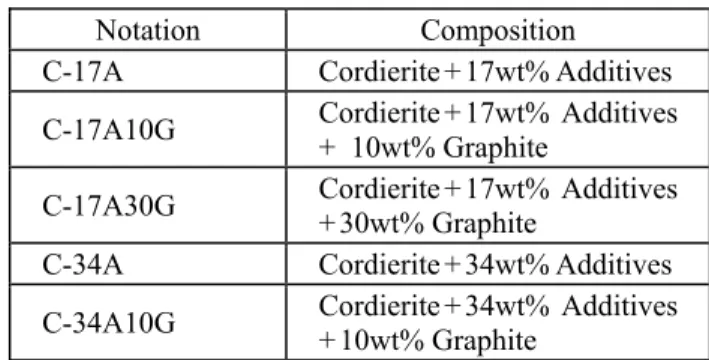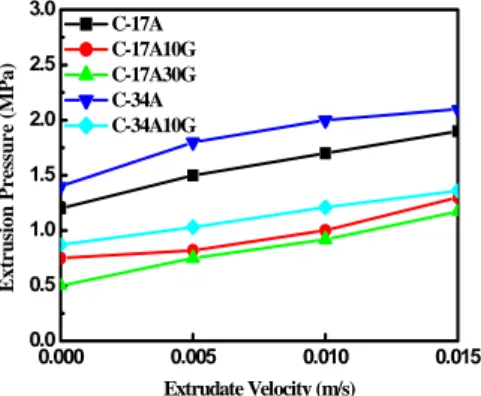© Korean Powder Metallurgy Institute 1009
-1. Introduction
Cordierite honeycomb with porous body has a great advantage in the industrial applications such as catalyst carrier for automobile and high temperature gas filter [1-4]. Key factors in the application of high temperature filter are known as high surface area and compressive strength. Aluminium titanate, mullite, zirconia, spodumene, and cordierites with high surface area and good adsorption properties are used as a ceramic filter [5]. Among those materials, cordierite has been a good candidate due to its high thermal shock resistance and low thermal expansion coefficient [6, 7]. Because the major chemical components of cordierite are Al2O3, SiO2, MgO, cordierite is fabricated
by fly ash, talc, and kaolin as a raw materials. In this study, we attempted to fabricate the cordierite honeycomb using fly ash known as an industrial waste. Also the effect of graphite additive as a porosifier as well as lubricant during the extrusion process of honeycomb body was investigated.
2. Experimental and Results
As a starting powder for cordierite synthesis, fly ash (Youngdong power plant, Korea), MgO (Kosundo chemical, Japan) were used. Chemical composition of fly ash was shown in table 1. Cordierite powder was synthesized from the solid state reaction method at 1100oC. Synthesized
cordierite was mixed with binder (Methyl Cellulose, Showa Chemical, Japan), plasticizer, (Glycerol, Showa Chemical, Japan), and lubricant (LU-6418, Cell Chemical, Korea) for the extrusion of honeycomb body. During the extrusion of cordierite honeycomb, extrusion pressure was controlled. After extrusion, honeycomb was dried for 12 h with the
control of moisture and temperature, and then heat treated at 1000oC ~ 1250oC. Extrusion additives (binder, plasticizer,
lubricant) were varied to control the optimum condition for honeycomb properties. Also, graphite was added to replace the lubricant as well as to enhance the pore formation. Table. 2 shows the compositions of honeycomb used in this study. Physical properties of honeycomb were investigated using porosimeter, compressive stress (Instron, 5882, USA).
Table. 1 Chemical composition of fly ash.
Table. 2 Specimen notations of cordierite honeycomb.
Fig. 1 shows the variation of honeycomb shrinkage with the extrusion additives. This results suggest that the impurity content in graphite powder was affected the densification of cordierite honeycomb due to the liquid
2006 POWDER METALLURGY World Congress
PB07-W-05
Weight Percent (wt%) Component
SiO2Al2O3Fe2O3 K2O TiO2 CaO SO3MgO Na2O
Fly Ash 48.1 32.9 6.43 5.21 2.28 1.54 1.210.9700.421
Notation Composition C-17A Cordierite+17wt% Additives
C-17A10G Cordierite+ 10wt% Graphite +17wt% Additives C-17A30G Cordierite+30wt% Graphite +17wt% Additives C-34A Cordierite+34wt% Additives C-34A10G Cordierite+10wt% Graphite +34wt% Additives
Fabrication of Cordierite Honeycomb from Fly Ash
Sung-Jin Kim1,a, Sung-Jin Park1,b, Hee-Gon Bang1,2,c, Sang-Yeup Park1,2,d 1
Department of Ceramic Engineering, Kangnung National University, Kangnung, Kangwondo, 210-702, South Korea
2
Technology Innovation Center for Fine Ceramics, Kangnung National University, Kangnung, Kangwondo, 210-702, South Korea
a
k9s8j7@hotmail.com, bdark sung jin@hanmail.net,
c
hgbang@ kangnung.ac.kr dsypark@knusun.kangnung.ac.kr Abstract
In this study, we attempt to synthesize the cordierite from the reaction of fly-ash, alumina, silicon dioxide, and magnesia powders. For the purpose of air purification, the honeycomb filter with porous cordierite was fabricated from the combination of synthetic cordierite and pore forming agent. Fabricated porous cordierite honeycomb was prepared with high porosity (58%), and good compressive strength (69MPa).
© Korean Powder Metallurgy Institute 1010 -phase formation. This prediction was confirmed from rapid shrinkage rate above 1200oC due to the particle rearrangement and the viscous flow onset of liquid formation.
Fig. 2 shows the variation of extrusion pressure with extrusion additives as well as graphite addition. All the extrusion condition, extrusion rate was increased with increasing the extrusion pressure. However, extrusion pressure was decreased with increasing the graphite addition. This result implied that graphite addition was resulted from the enhancement of flow ability due to the relaxation of fraction stress between cordierite particles.
Fig. 3 shows the variation of porosity and compressive strength with sintering temperature and extrusion composition. With increasing the extrusion additives, porosity was increased. However, graphite addition was not effective for the porosity increase. This result was confirmed in the compressive strength data.
Therefore, graphite addition was effective only for the enhancement of extrusion rate similar to lubricant additive due to the impurity content in graphite powder.
1000 1050 1100 1150 1200 1250 0 5 10 15 20 25 30 35 40 Temperature (oC) Li n ear Sh ri nk age ( % ) C-17A C-17A10G C-17A30G C-34A C-34A10G
Fig. 1. Linear shrinkage of cordierite with different amounts of organic matter and graphite.
0.000 0.005 0.010 0.015 0.0 0.5 1.0 1.5 2.0 2.5 3.0 Ext ru si o n Pr es su re (M P a ) Extrudate Velocity (m/s) C-17A C-17A10G C-17A30G C-34A C-34A10G
Fig. 2. Effect of organic matter and graphite addition extrusion pressure. 1000 1050 1100 1150 1200 1250 20 40 60 80 100 20 40 60 80 100 C-17A C-17A10G C-17A30G C-34A C-34A10G Appar ent Poro sity (% ) Temperature (oC) C o m p re ss iv e St re n g th ( M P a )
The optimum condition of a ceramic honeycomb filter.
Compressive Strength Porosity
1000 1050 1100 1150 1200 1250 20 40 60 80 100 20 40 60 80 100 C-17A C-17A10G C-17A30G C-34A C-34A10G Appar ent Poro sity (% ) Temperature (oC) C o m p re ss iv e St re n g th ( M P a )
The optimum condition of a ceramic honeycomb filter.
Compressive Strength Porosity
Fig. 3. Variation of compressive strength on and apparent porosity in honeycomb structure with different amounts of organic matter and graphite.
3. Summary
Cordierite honeycomb filters were fabricated using fly ash. With increasing organic binder content, porosity in the honeycomb increased and compressive strength was decreased. Porous cordierite honeycomb with high porosity (58%) and good compressive strength (69MPa) was obtained by the addition of 30wt% graphite at low sintering temperature (1150oC). Although graphite addition was not
effective for the increase of porosity in honeycomb body, it was effective for the increase of compressive strength and the decrease of extrusion pressure during the honeycomb process. This result is believed that the impurity content in the graphite was attributed to the enhancement of densification and particle binding force in the ceramic honeycomb body.
4. References
1. Jin Yang: Journal of the Korean Ceramic Society Vol.35, No. 4, pp. 399-405 (1998).
2. J. D. Chung, Environ. Eng. Res., 2(1), 33-40 (1997). 3. A. Bueno-Lopez, D. Lozano-Castello, I. Such-Basanez, J. M. Garcia- Cortes, M. J. Illan-Gomez, C. Salinase-Martinez de Lecea, Applied Catalysis B : Environmental 58, 1-7 (2005).
4. Alessandro Bachiorrini, Ceramics International 22, 73-77 (1996).
5. Y. Sawada, K. Hiramatsu, H. kawamoto et al: High Temperature Gas Cleaning, Volume II, 393-404 (1999). 6. Young-Bae Kim, Eul-Hoon Cho, Yoon-Young Chang, Hee-Soo Lee and Duck-Kyun Choi: Korean Journal of Material Research Vol. 12, No. 2 (2002).
7. M.A.Camerucci, G.Urretavizcaya, A.L.Cavalieri : Ceramics International 29 (2003) 159-168.

